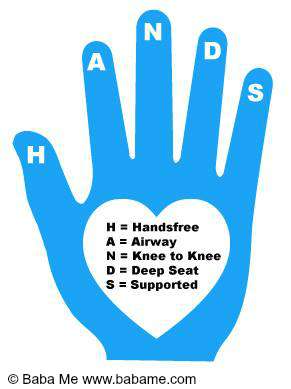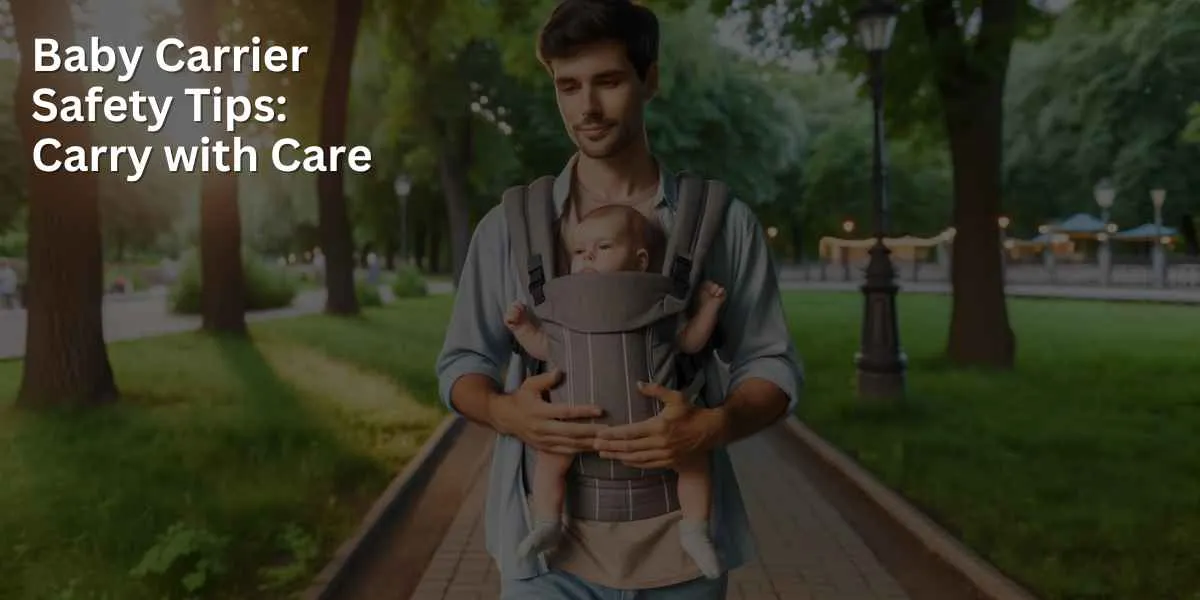Ensuring safety in baby carriers is paramount for parents who want to keep their little ones close and secure. While baby carriers offer a convenient way to carry your child, understanding how to use them safely is crucial.
Whether you’re a first-time parent or experienced in baby wearing, these safety tips will help you confidently and safely use a baby carrier.
Hello, I’m Maebh Collins, a seasoned baby carrier consultant with over two decades of experience. As a certified expert in both Trageschule and Slingababy, I’ve had the privilege of assisting thousands of families in their journey to find the perfect baby carrier. Welcome to a world of comfortable, confident babywearing!
Key Takeaways: Baby Carrier Safety
- Ensure proper hip and spine positioning. The carrier should support the baby’s hips in an ‘M’ position and keep their spine in a natural, curved ‘C’ shape.
- Check weight and age recommendations. Each carrier has specific guidelines for weight and age, which are important for safety and comfort.
- Keep baby’s airways clear. Ensure the baby’s face is visible and not pressed against the fabric or the wearer’s body.
- Practice ‘T.I.C.K.S.’ for safe babywearing. This stands for Tight, In view at all times, Close enough to kiss, Keep chin off the chest, and Supported back – this mainly focuses on airway.
- Practive H.A.N.D.S for safer babywearing – Handsfree, Airflow, Knee to Knee, Deep Seat, Secure.
- Avoid carriers with narrow bases for newborns and infants. A narrow base can lead to unsafe hip positioning, potentially contributing to hip dysplasia.
- Use infant inserts if needed. Some carriers require inserts for newborns to ensure they are positioned safely and comfortably.
- Regularly check for wear and tear. Examine the carrier for any damage or loose stitching that could compromise its safety.
- Start with short sessions. Especially for new wearers, shorter sessions help you get used to the carrier and ensure the baby’s comfort.
- Be mindful of your activities while wearing the carrier. Avoid activities where you could lose balance or put the baby at risk.
- Read the manual and watch instructional videos. Proper usage instructions are crucial for the safety and comfort of both baby and wearer.
Babywearing Safety Measures and Guidelines
Babywearing can be a wonderful way to bond with your little one while keeping your hands free for other tasks. But, it’s important to keep safety in mind. Here are some friendly guidelines to help you make sure you’re practicing safe babywearing.
T.I.C.K.S Checklist
To keep you and your baby comfortable and secure, follow the T.I.C.K.S checklist:
- Tight: Make sure the carrier is snug to keep your baby supported and close to your body.
- In view at all times: Your baby’s face should be visible so you can monitor their breathing.
- Close enough to kiss: Baby’s head should be at a height where you can easily give them a kiss on the head.
- Keep the chin off chest: Make sure there’s a two-finger gap below the baby’s chin to allow for proper breathing.
- Supported back: Ensure the carrier offers adequate back support for your baby, so they don’t slump down.
Choose the Right Position
The recommended position for babywearing is the upright position rather than the cradle position. This helps to prevent your baby’s airway from being blocked and reduces the risk of developing hip dysplasia.
The baby’s legs should ideally be in an “M” shape, with their knees higher than their buttocks for healthy hip positioning. The international hip dysplasia institute has a Hip Healthy label which they put on a baby sling or carrier which they have deemed provides safe ergonomic positions. Leading brands such as Ergbaby, Lillebaby and Babybjorn all carry these labels.
To ensure the right position use the HANDS (which we think is better than Ticks as it looks at all parts of babywearing and not just the airway.
Safety Guidelines Using the HANDS Method
Hands Free – Straps and Buckles Adjustment Ensure straps and buckles are correctly adjusted for hands-free support. Follow the manufacturer’s guidelines for a snug, secure fit, promoting even weight distribution and comfort for both baby and carrier.
Airway Free – Ensuring Proper Position The baby’s position is vital for safety. Adjust the carrier to keep the child’s head forward and face visible, with no obstructions to the nose and mouth. This helps maintain an unblocked airway, vital for easy breathing and preventing suffocation.
Knee to Knee – Support Proper support for the baby’s hips is essential. The carrier should support from knee to knee, allowing natural leg bending. This ergonomic position supports healthy hip development and avoids leg and hip strain.
Deep Seat – Stability and Comfort Adjust the carrier for a deep seat, ensuring the baby’s bottom is in the deepest part, with legs wrapping around the wearer’s waist. This distributes weight evenly and maintains a secure, ergonomic position.
Supported – Head and Neck Stability Adequate head and neck support, especially for younger infants, is crucial. Look for carriers with adjustable features for proper support, preventing the baby’s head from falling forward or sideways. You should always feel that you can have your hands free – the carrier should completely keep your baby close and safe to you.
Safety Measures to Implement
- Always check the carrier before wearing to ensure it is in good condition and all its buckles, snaps, and seams are secure.
- While babywearing, avoid activities that could risk your baby’s safety (e.g., cooking, exercising, or riding a bike).
- Be aware of the surroundings to prevent accidents (e.g., bumping into sharp objects or hot surfaces).
- Regularly check on your baby to make sure they are comfortable, breathing well, and not overheating to keep your baby safe in baby slings.
With these safety measures and guidelines in mind, you can enjoy the benefits of babywearing while keeping your precious little one safe and secure. Best of luck on your babywearing journey!
Safety First – Help and Advice for babywearing
We care about the safety of you and your babies which is why we have 10 specially trained staff on hand to guide you through our carriers. They’ll ask you questions about your babies weight, how many months old they are, how long you wish to continue carrying, the type of support you need and even the type of fabric you like as there are loads of options available.
They can advise on what to wear while wearing baby, both for you and your child, or the best carriers and wraps for hot weather. As well as carrying positions and how best to achieve them. And provide tips and advice on care and washing.
Though we say there are no best baby carriers there are those that haven’t been designed with baby safety and development in mind. All our structured carriers are ergonomically designed to support and protect and should only be used in the carrying positions they have been designed for.
We are proud of our customer service and take pride in making sure you get the best product, design, fabric and support for you.
I have been teaching people to use carriers for over thirteen years now, and in that time, much of the advice regarding safely using baby carriers has changed significantly.
A few years ago TICKS was published which became the standard for baby carrier safety. However, as a baby carrying consultant and running a busy retail store I have found parents get confused by this, and struggle to remember it. On this basis, in our shop and at my own personal baby carrying consultations for the last twelve months, I have preferred to use what I call the HANDS Baby Carrier Safety Guide.

This very simple graphic and acronym is easily explained and easily remembered by parents, as baby carriers do what it states, lets them be hands free.
H = Hands free. You should have both hands and arms free when using a baby carrier. If you feel the need to use your hands to support baby, then double check it is fastened correctly and safely.
A = Airway. Always, once you have fastened baby into the baby carrier, check their airway is clear and unrestricted.
N = Knee to Knee. Check the fabric is knee to knee supporting baby, but that baby can still move their knees and lower legs freely.
D = Deep seat. Run your hand along their bum and check it is a nice deep seat position, with a nice gentle ‘j’ curve running from bottom of the bum up the back.
S = Supported. Ensure your baby is supported, with a nice tight carry and the chin is off the chest. I get parents to gently lean forward and ensure baby does not ‘move’, any movement then double check your tension and retighten.
Feedback from parents in our shop and in my private consultations, when using the above method, has been excellent. They find this much much easier to remember and run through after they have put baby into their carrier. It is also suitable and relevant for all carries, including back carries. I hope you like it and I look forward to your feedback.
FAQS on How to Carry A Baby Safely
Are baby carriers safe for infants, including those with low birth weight?
Baby carriers are generally safe for most babies, including those with low birth weight, when used correctly and if the carrier is designed for their size. It’s essential to ensure that the carrier provides adequate support for the baby’s neck, back, and hips. For infants, especially those with low birth weight, the carrier must maintain them in a safe and ergonomic position, supporting their development and comfort.
How can I ensure my baby, especially with low birth weight, is safe in a carrier?
To ensure the safety of your baby in a carrier, especially if they have low birth weight, make sure the carrier fits well. The baby should be in a ‘spread squat’ position, which is crucial for healthy hip joint development. The carrier should also support the baby’s neck firmly and allow you to see their face at all times to monitor their breathing. Regularly checking the carrier’s integrity and adjusting it to accommodate your baby’s growth is important.
What are the safety rules for babywearing, particularly for infants with low birth weight?
The safety rules for babywearing, especially for infants with low birth weight, include:
- Visibility and Airway: Keep the baby’s face visible and ensure their airways are clear.
- Neck and Back Support: The carrier should support the baby’s neck and back adequately.
- Ergonomic Positioning: Position the baby in a ‘spread squat’ manner, ensuring the hip joint is well supported.
- Comfort and Monitoring: The baby should be high enough for you to kiss their forehead, and you should frequently check on their comfort and position.
For how long can a baby, particularly those with low birth weight, be safely carried in a carrier?
The length of time a baby can be safely carried in a carrier varies; however, for most babies, including those with low birth weight, the key is the baby’s and wearer’s comfort. It’s important to ensure that the baby spends time in a position that supports their hip joint and spine correctly. Regular breaks are advisable to prevent discomfort, especially for babies with low birth weight, and adjustments might be needed to maintain proper support as both you and your baby change and grow.





